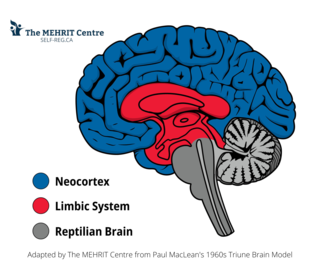
Adolescence
Help, I Don’t Speak Limbic
How to talk to a teen when he’s “gone limbic."
Posted January 18, 2017 Reviewed by Jessica Schrader

It was a conversation like dozens of others that I’ve had. A 14-year-old teen had just gotten into trouble at school for the silliest of reasons, and when threatened with suspension he just kept repeating over and over: “I don’t care.” The school agreed to give him “one last chance,” but warned his parents that their son had run out of “last chances.” Which is why his mom had come to see me.
“How can he keep doing such stupid things?” she wailed. “How can he say he doesn’t care?” And then the capper: “I’m worried that he’s going a little crazy!”
The interesting thing is, his behavior may not have been particularly rational, but neither was it irrational. It was the sort of mindless thing that teenagers do all the time, not just to impress their peers, but because of the changes that are happening in their brain—not to mention their bodies. But mom hadn’t come to me to talk about the biological vagaries of adolescence; all she wanted was some help in regards to talking to her son, which is where Self-Reg comes in.
Self-Reg capitalizes on the idea of the Triune Brain that Paul MacLean developed back in the 1960s: the “three different brains” selected at different times in evolutionary history (reptilian, paleo-mammalian, and neocortex). Self-Reg draws from this metaphor a crucial lesson about the difference between rational and limbic states, which are supported by very different neural networks. Each is vital for human survival: the former in low-stress conditions, the latter in high-stress.
When a teen is rational, he is able to process what we’re saying; pause and reflect before he acts; sequence his thoughts; see the connection between cause and effect; balance short-term against long-term goals; anticipate the consequences of an action.
It is tempting to define “limbic” as simply the absence of these rational traits. But, in fact, it has its own unique set of characteristics, which, in the right circumstances, can be incredibly powerful.
The most notable features of the limbic state are the “survival” traits: e.g., being hypervigilant for signs of danger (auditory, visual, olfactory); fleeing or fighting at the slightest provocation; being hyperfocused; seeking a place of safety; mobilizing resources to prepare the body for intense exertion.
The limbic state also serves a critical social function. “Limbic resonance”—a limbic-to-limbic connection—is a direct communication channel, which is crucial for intuitively knowing what each other is thinking and for the shared emotions that sweep through and bind together a group.
The basic “neuroceptive” ability to recognize someone as a potential threat, and equally, as a source of safety and security, is made possible by the limbic capacity to form emotional associations [neuroception].
The limbic state also produces a state of diminished interoception. Our awareness of all sorts of homeostatic signals—e.g., pain, fatigue, thirst, temperature—is blunted, as are emotional awareness and empathy [alexithymia].
To this day, we celebrate individuals who develop these limbic capacities. Great athletes, for example, tap into the capacity to ignore pain, fatigue, thirst, body temperature, while scanning for threats (think of how Olympic runners look about to see where their competitors are). Champions are those who able to “push themselves beyond their limits”—or at least, past others’ limits.
Shifting into a limbic state would have been invaluable for the Pleistocene environment in which humans evolved; and it continues to be so today. What this really means is that teens are confronted with a twofold problem: Not only do they have to learn when and how to avoid going into a limbic state, but equally, when and how to capitalize on being in such a state. (I say this as the father of one teenager who is a hockey player and another who’s a swimmer!)
The whole point of this distinction between rational and limbic when it comes to talking to our teens is that it forces us to consider which family of concepts applies to the behavior that we’re encountering: Is he capable of pausing and reflecting before he acts? Is he capable of knowing what he’s doing? Is he even capable of knowing what he’s feeling?
Similar questions apply to what a teen is saying; for the different types of “limbic behavior” are associated with distinctive types of vocalization. Rats, for example, make pleasure calls in the 22-kHz range and distress calls in the 50-kHz range. A similar frequency-change is evident in small children: e.g., when they scream in excitement or frustration.
Where the distinction is pivotal is when we consider the consequences of treating a teen as if he were rational when in fact he is limbic. The teen’s all-too-familiar “I don’t care” response to being chastised for something that he’s done or said only infuriates us more. But pause and listen carefully and you’ll notice that his voice is high-pitched and strained, the speech rhythms harsh and percussive.
There are so many things going on when a teen insists “I don’t care.” He may well be trying to convince himself that this is the case; his utterance may be an explosion of anger; denial; avoidance; escape; anxiety; panic. Odds are it’s a combination of all of the above.
Put it all together and what you have is the adolescent version of the sort of 50-kHz “distress cry” that typifies a limbic state. Far from being an act of defiance, it is more likely the result of feeling paralyzed because of being constrained: not necessarily physically, but by the situation or our authority. This is a feeling that, if consistently ignored, or still worse, punished, can indeed lead to an externalizing disorder.
All too often, we misinterpret what a teen is “saying” because of mindblindness: i.e., we fail to recognize which state the child is in. The truth is that, past a certain age (typically 3), we cease to see limbic behaviors for what they are. A form of mindlessness sets in, where we commit the category-error of applying concepts that apply to the rational state to what is, in fact, limbic.
Self-Reg teaches us how to recognize when a teen is in a limbic state and how to respond accordingly. It teaches us how to “speak limbic”: how to interpret the meaning of limbic utterances and how to respond; to reframe what sounds aggressive for what is, in fact, self-defensive. Whether or not the teen’s utterances are “requests” for assistance, they are most certainly indicators of the need for assistance.
The teen eventually needs to learn all this for himself: needs to know when he is limbic. Being in this state in the wrong circumstances can be costly for him in so many ways: not just in terms of the amount of energy he burns and the impact this has on his mood and perception, but for his learning and social relationships, his personal insight, and moral growth. The problem, however, is that you can’t simply “tell” a teen that he’s in a limbic state, using the sort of language that you’d use when he’s fully rational.
A teen’s comprehension when he’s limbic undergoes the same sort of transformation as his speech. He becomes attuned to your own limbic messages: what he is processing isn’t so much the semantic content of what you’re saying but rather, your tone of voice, facial expression, body language, gestures. Even if this is not at all your intention, if you are inadvertently sending “threatening” messages you can be sure that that is what he’s picking up. And because of the impact of the limbic state on his social cognition (e.g., negative bias), that may be all that he is picking up: regardless of what you’re saying!
The point is that, in a limbic state, a teen may have as little idea of what you’re really saying as to what he’s “saying.” To help him transition back to rational, we have to help him self-regulate. We do this by softening our eyes, lowering our tone of voice, slowing our speech rhythm, and relaxing our facial expression, gestures, posture. Provided we allow him the time it takes for the message to sink in—and every teen is different in this regard—he will eventually “tell” you, with his own affect signals, if not his words, that he does indeed care, and what’s more, that he’s absorbed at least some of the lesson that you were trying to impart.
A teen doesn’t know when he’s limbic and he certainly may not know how to get out of that state. What’s more, it’s much easier to slip from rational into limbic than the reverse. We continue to guide these state-transitions until such time as the teen can do so on his own, similar to the way that an instructor helps teens in driver’s ed.
This is why it is so important to distinguish the different kinds of “triune behavior” and know how to respond accordingly. But it is impossible to exercise these rational responses to a teen’s hyperarousal if we ourselves are hyperaroused. And there is no bigger stress on a parent or educator than not understanding how a teen could do or say the things he is doing or saying.
If we ignore or misread a teen’s limbic actions and utterances, he will indeed end up resorting to “reptilian” survival strategies. Similarly, the teen’s capacity to pause and reflect hinges on our own ability to pause and reflect. But this is no more a matter of self-control in us than it is in the teen. It is a case of being aware of the stress we are both under and knowing how to mitigate it. And there is no bigger stress when it comes to talking to a teen then misreading the signs of when he’s “gone limbic.”



